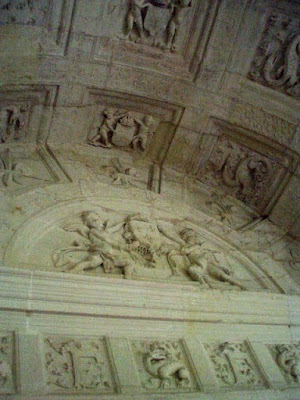Happy and full, we rejoined our tour and set off for the next château. On the way, we snapped this photo of a different castle, Chaumont, and its surrounding village. Guess we'll have to save that one for another trip.
I would describe the Château Cheverny as more of a manor house than a castle. It was built in the 1620's and renovated in the 1780's.
Here are some past members of the family: Philippe Hurault, his wife Anne de Thou, and one of his brothers.
A quick tour of the interior:
 |
| Red tortoiseshell Boulle-style chest of drawers, family dining room, two-thousand-volume library |
 |
| Ornate fireplace, the gaudy Grand Salon, bridal gown worn by the current Marquise at their wedding in 1994 |
Another thing that set Cheverny apart was the emphasis on hunting, specifically fox hunting. There is a kennel onsite housing the 100 or so French hunting hounds belonging to the Marquis. I would not want to be the poor guy in charge of cleaning up!
 |
| "Release the Hounds!" |
In the Middle Ages, owning a dovecote was a sign of wealth and status -- only nobleman could own one. The pigeons and their eggs were an important food source and their droppings were used for fertilizer. Nowadays the vine-covered dovecote at Cheverny is used as a water tower for irrigating the kitchen/flower garden.
Okay, one last view of Cheverny from the English garden before we head on to the next castle.
On to the tour! The castle's best-known feature is its central double-helix spiral staircase. There are two spiral staircases winding around a central hollow column. So if two people each take a different staircase they can each ascend at the same time without seeing each other (very handy if you have a mistress). It is possible that inspiration for this staircase came from the king's friend, Leonardo da Vinci.
I'm not sure if we were confused by the staircase, or the castle's impractical layout, or just plain château-ed out, but we kind of breezed through the rooms and did not take very many photos. After four palaces full of bedrooms, do you really need to see another one? Well, okay...
The vaulted ceilings were ornamented with decorative carvings.
Hunting trophies in one of the galleries.
This room was filled with some of the original towers from the roof. The entire castle is made of tufa stone, which is a type of limestone that is easily carved but succumbs to erosion over time. Major restoration work was begun just after WWII, and some of it continues today.




















No comments:
Post a Comment